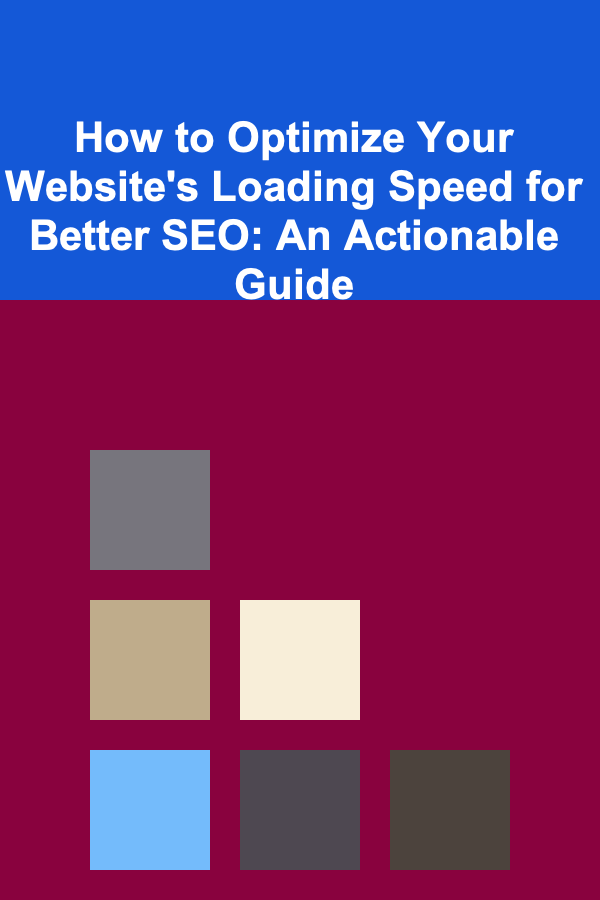
How to Optimize Your Website's Loading Speed for Better SEO: An Actionable Guide
ebook include PDF & Audio bundle (Micro Guide)
$12.99$6.99
Limited Time Offer! Order within the next:

Website loading speed is no longer just a user experience issue---it is a critical ranking factor for search engines like Google. In today's digital landscape, where attention spans are short, every second of delay can cost you potential visitors, conversions, and search engine rankings. Optimizing your website's speed not only improves user experience but also has a direct impact on your SEO performance.
This actionable guide will provide you with practical steps to enhance your website's loading speed and help you achieve better SEO outcomes.
Why Website Speed Matters for SEO
Search engines, particularly Google, have increasingly prioritized website loading speed as an important ranking signal. Google's Core Web Vitals, introduced as part of the page experience update, measure how users experience the performance of a page. These include key metrics like Largest Contentful Paint (LCP), First Input Delay (FID), and Cumulative Layout Shift (CLS).
A slow website can hurt your rankings in several ways:
- Increased Bounce Rates: Slow-loading pages result in higher bounce rates, signaling to Google that users are dissatisfied with the content.
- Lower User Engagement: Visitors are less likely to engage with your content, reducing time spent on site and conversion rates.
- Reduced Crawl Efficiency: Googlebot has a limited crawl budget. If your website takes too long to load, Googlebot might not be able to crawl all your pages efficiently, leading to fewer pages indexed.
In contrast, a fast-loading website enhances user experience, builds trust, and ultimately helps your rankings. The faster your website loads, the better the chances for higher SEO scores and improved organic search visibility.
Analyze Your Current Website Speed
Before diving into optimization, it's important to assess your website's current loading speed. There are several free and paid tools available that can help you evaluate your website's performance and identify areas for improvement.
Tools to Measure Website Speed:
- Google PageSpeed Insights: Provides detailed insights into your website's performance on both desktop and mobile. It also offers recommendations for improvement.
- GTmetrix: Offers performance analysis with both page speed and YSlow scores, along with actionable insights.
- Pingdom: A popular tool for measuring page speed and getting a detailed breakdown of the loading process.
- WebPageTest: Allows you to test your website from multiple locations around the world, simulating real-user experiences.
Once you've tested your site, focus on understanding the following performance metrics:
- Time to First Byte (TTFB): Measures how long it takes for the browser to receive the first byte of data after making an HTTP request.
- Fully Loaded Time: The time it takes for the entire page to load, including images, scripts, and styles.
- Page Size: The total size of the webpage, including all assets such as images, CSS, and JavaScript files.
By understanding your website's current speed, you can develop a clear action plan for optimization.
Optimize Images for Faster Load Times
Images often account for the bulk of a webpage's total size, making them one of the biggest contributors to slow load times. Optimizing images is essential for speeding up your site.
Steps to Optimize Images:
- Resize Images: Ensure images are not larger than necessary. For example, if you only need an image to display at 800px wide, don't upload an image that is 3000px wide.
- Use Appropriate File Formats :
- JPEG is best for photographs or complex images.
- PNG is suitable for images with transparency or simple graphics.
- WebP offers better compression and quality than both JPEG and PNG, making it an excellent choice for most images.
- Compress Images : Use tools like TinyPNG , ImageOptim , or Squoosh to compress images without losing noticeable quality. You can also use WordPress plugins like Smush or ShortPixel for automatic image compression.
- Lazy Loading: Implement lazy loading to ensure that images only load when they appear on the screen (i.e., as the user scrolls down the page). This reduces the initial loading time for pages with many images.
Minimize HTTP Requests
Each time a user visits your website, the browser sends HTTP requests to the server to load all your website's resources---CSS files, JavaScript files, images, fonts, etc. Too many HTTP requests can significantly slow down the page load time.
Ways to Reduce HTTP Requests:
- Combine CSS and JavaScript Files: Instead of having multiple CSS or JS files, combine them into a single file for each type. This reduces the number of requests the browser makes.
- Use CSS Sprites: If your website uses several small images (like icons), combine them into a single image (sprite). This reduces the number of HTTP requests, as only one image is needed.
- Remove Unnecessary Files : Get rid of unused CSS, JavaScript, or images that are not essential to the page. Tools like PurgeCSS can help remove unused CSS.
- Preload Key Resources : Use the
preloadlink relation to instruct the browser to prioritize certain resources, such as fonts or critical CSS, before the rest of the page is loaded.
Enable Browser Caching
Browser caching allows browsers to store certain files locally, which means that when users visit your site again, the browser doesn't need to re-download the same files. This significantly speeds up page load times for return visitors.
Steps to Enable Browser Caching:
- Set Expiry Dates or Cache-Control Headers: Configure your web server to instruct the browser to cache resources for a specific amount of time. For example, images could be cached for a week, while CSS or JavaScript files may be cached for a month.
- Leverage Tools for Caching : If you're using a Content Management System (CMS) like WordPress, you can install plugins such as W3 Total Cache or WP Super Cache to easily enable caching.
- Use a Content Delivery Network (CDN): A CDN stores copies of your website's static assets (like images and scripts) on multiple servers around the world. This reduces load times by serving resources from the server closest to the user.
Reduce Server Response Time
The time it takes for your server to respond to requests plays a key role in your website's loading speed. If your server is slow to respond, it can negatively affect performance, no matter how optimized the rest of your site is.
How to Improve Server Response Time:
- Choose a Reliable Web Hosting Provider: Invest in a reputable hosting provider that offers fast, reliable servers. Shared hosting may be cheaper, but it can also result in slower speeds due to shared resources.
- Optimize Database Queries : Slow database queries can delay the server response time. Ensure your database is optimized, and consider using a database caching solution like Redis or Memcached to speed up data retrieval.
- Use PHP 7 or Higher: PHP is a server-side language commonly used by WordPress and other CMS platforms. Upgrading to the latest version of PHP can significantly improve server response times.
Minify and Compress CSS, JavaScript, and HTML Files
Large CSS, JavaScript, and HTML files can slow down the loading time of your website. Minification and compression remove unnecessary spaces, comments, and characters from the code, making the files smaller and faster to download.
How to Minify and Compress Files:
- Minify Code : Use tools like UglifyJS (for JavaScript), CSSNano (for CSS), and HTMLMinifier (for HTML) to remove unnecessary characters from your code.
- Gzip Compression: Enable Gzip compression on your server to compress text-based resources like HTML, CSS, and JavaScript before they're sent to the browser. This can reduce file sizes by up to 70%.
- Use Asynchronous or Deferred Loading for JavaScript: Ensure that non-essential JavaScript files are loaded asynchronously or deferred, so they don't block the rendering of the page.
Implement Mobile Optimization
With more users browsing websites on mobile devices than ever before, ensuring your website is optimized for mobile performance is crucial for both user experience and SEO.
Mobile Optimization Tips:
- Responsive Design: Ensure your website uses responsive web design, so it adjusts to fit different screen sizes without affecting load times.
- Mobile-First Approach: Prioritize mobile performance during the design and development stages. Google uses mobile-first indexing, meaning it primarily uses the mobile version of your site to rank it.
- Optimize Touch Elements: Make sure touch elements like buttons and menus are well-sized and easy to interact with on mobile devices.
Use a Content Delivery Network (CDN)
A CDN distributes your website's content across multiple servers around the globe, ensuring that users access your site from a server closest to their location. This reduces latency and load times.
Benefits of Using a CDN:
- Improved Speed: By serving assets from a server closer to the user, CDNs reduce load times.
- Reduced Server Load: CDNs offload traffic from your main server, reducing the load on your hosting provider.
- Better Security: CDNs can protect your site from DDoS attacks and other malicious activities.
Popular CDN services include Cloudflare , Amazon CloudFront , and KeyCDN.
Monitor and Maintain Website Performance
Website optimization is an ongoing process. After implementing these strategies, regularly monitor your website's performance to ensure it continues to load quickly.
- Set Up Performance Alerts : Use tools like GTmetrix or Pingdom to set up alerts whenever your website's loading speed drops below a certain threshold.
- Regularly Update Plugins and Themes: Ensure your CMS, themes, and plugins are always up to date, as outdated software can slow down performance.
Conclusion
Website loading speed is crucial for both SEO and user experience. By following these actionable steps, you can enhance your website's performance, reduce bounce rates, and improve your search engine rankings. Start by measuring your current speed, then implement strategies like image optimization, reducing HTTP requests, enabling caching, and using a CDN. With consistent monitoring and maintenance, you'll ensure that your website remains fast and competitive in search results.
Speed isn't just about improving rankings---it's about offering visitors a better experience and ensuring that your content reaches as many users as possible.
Other Products

How to Incorporate Sustainable Home Staging Tips
Read More
How to Invest in Real Estate Without Owning Property
Read More
How to Provide Advertising Design and Production Services: A Comprehensive Guide
Read More
How to Store Your Holiday Gifts Before Giving Them Away
Read More
How to Use Shelf Risers for Better Kitchen Organization
Read More